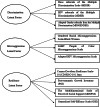Testing for Measurement Invariance (MI): Do the Structures of Microaggression, Discrimination, and Resilience Among Black Women Living with HIV Remain the Same Across Time?
- PMID: 39102174
- PMCID: PMC12184700
- DOI: 10.1007/s40615-024-02087-w
Testing for Measurement Invariance (MI): Do the Structures of Microaggression, Discrimination, and Resilience Among Black Women Living with HIV Remain the Same Across Time?
Abstract
Assessing measurement invariance and the interplay of discrimination, microaggressions, and resilience among Black women living with HIV (BWLWH) across time utilizing latent class and repeated measure analysis may provide novel insights. A total of 151 BWLWH in a southeastern U.S. city completed surveys focused on multiple forms of microaggressions and discrimination (race, gender, sexual orientation, or HIV-related) and resilience factors (social support, self-efficacy, post-traumatic growth) at baseline, 3 months, and 6 months. To capture the psychosocial domains of discrimination, microaggressions, and resilience, three latent factors were developed and measured across three time points. Latent class analysis was also conducted to identify and compare meaningful subgroups based on varying levels of discrimination, microaggressions, and resilience reported. Three latent classes were created. MI testing suggested that measurement invariance was partially met (established metric invariance and scalar invariance), and it is possible to compare factor means of discrimination, microaggressions, and resilience across time. Latent factor mean scores of microaggressions and discrimination decreased after 3 and 6 months and increased for resilience after 6 months and varied over time across the three latent classes identified. The subgroup with the lowest level of discrimination and microaggressions and the highest level of resilience reported at baseline, experienced increases in resilience after months 3 and 6. Clinical interventions, research, and policies aimed at promoting resilience and reducing structural and social barriers linked to racism, sexism, HIV stigma, and classism are needed to improve the health and well-being of BWLWH.
Keywords: Black women; Discrimination; HIV; Latent class analysis; Measurement invariance; Microaggression; Repeated measure analysis; Resilience.
© 2024. The Author(s).
Conflict of interest statement
Declarations. Ethics Approval: This study was performed in accordance with the principles of the Declaration of Helsinki All study procedures and materials were approved by the Institutional review Board at the University of Miami (7/26/2019, No. 20190713). Consent to Participate: Informed consent was obtained from all individual participants included in the study. Consent for Publication: Research participants have provided informed consent for the publication of the research findings in a peer-reviewed journal. Competing Interests: Unrelated to data in this manuscript, Dr. Dale is a co-investigator on a Merck & Co. funded project on “A Qualitative Study to Explore Biomedical HIV Prevention Preferences, Challenges and Facilitators among Diverse At-Risk Women Living in the United States” and has served as a workgroup consultant on engaging people living with HIV for Gilead Sciences, Inc. Dr. Safren receives royalties from books that he coauthored from Oxford University Press, Guilford Publications, and Springer/Human Press. All other authors declare that they do not have competing interests.
Figures
References
-
- Joint United Nations Programme on HIV/AIDS (UNAIDS) UNAIDS Report on the Global AIDS Epidemic. 2010. https://www.refworld.org/reference/annualreport/unaids/2010/en/92095. Accessed 15 Feb 2023.
-
- Centers for Disease Control and Prevention. HIV surveillance report, 2018 (Updated); vol. 31. 2020. http://www.cdc.gov/hiv/library/reports/hiv-surveillance.html. Accessed 15 Feb 2023.
-
- Cooper B. Intersectionality. In: Disch L, Hawkesworth M, editors. The Oxford handbook of feminist theory. New York: Oxford University Press; 2016. pp. 385–406.
-
- Crenshaw K. Demarginalizing the intersection of race and sex: a black feminist critique of antidiscrimination doctrine, feminist theory and antiracist politics. In: Feminist legal theories. Routledge; 2013. pp. 23–51.
MeSH terms
Grants and funding
LinkOut - more resources
Full Text Sources
Medical
Miscellaneous



